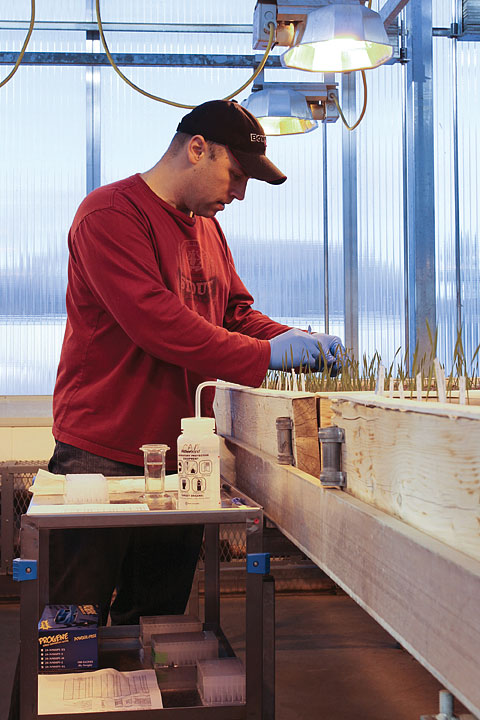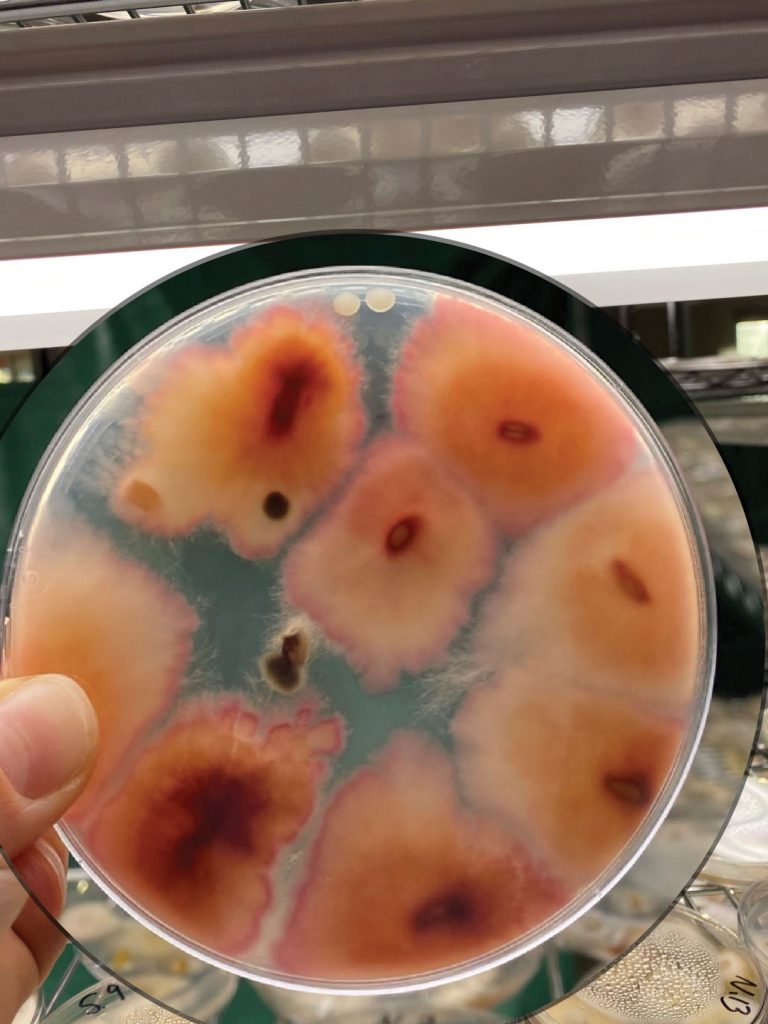FHB RESISTANCE IN DURUM A WORK IN PROGRESS
BY LEE HART • FUSARIUM INFECTED DURUM SPIKE PHOTO COURTESY OF RON KNOX
The improvement of Fusarium head blight (FHB) resistance in durum wheat varieties is no easy task, but progress has been made in recent years. Varieties with improved resistance are in the breeding pipeline.
The development of FHB resistance in durum is a complex challenge, said Curtis Pozniak, director of the University of Saskatchewan’s Crop Development Centre (CDC). He holds the university’s chair for the Strategic Research Program in Durum and High Yield Wheat Breeding and Genetics. The search for FHB resistance also involves researchers at CDC and several Agriculture and Agri-Food Canada (AAFC) research centres across Western Canada.
Pozniak said it is unlikely we will see complete resistance to FHB in the short-term. The centre screens durum germplasm from around the world. Each year, it has also adopted new genomic technology and evaluates thousands of lines of traditionally cross-bred durum in disease nurseries across Western Canada. The identification of promising lines brings improved resistance closer.

In fact, AAFC durum breeder Yuefeng Ruan at the Swift Current Research and Development Centre said, in preregistration lines of durum, he sees at least seven that show improvement in FHB resistance. Plenty of evaluation remains to be done prior to registration, but it is encouraging. The hope is to identify more lines that could be rated moderately susceptible or intermediate, but time will tell.
FHB, primarily caused by Fusarium graminearum, has been on the radar of Western Canadian farmers and crop researchers for more than three decades. Ron Knox a plant pathologist and geneticist with AAFC in Swift Current, said Manitoba farmers were major producers of durum until the arrival of FHB eventually ended its production.
“There were a number of factors at play,” said Knox. “Disease prevalence is highly influenced by the environment, particularly moist growing conditions, durum wheat is highly susceptible to the disease and there was also a cropping practices away from conventional tillage to more zero-till and conservation farming practices. These and other factors combined to favour disease development.” Climate change is an additional factor in FHB spread, he added.
Most Canadian durum wheat production today is in regions such as southern Saskatchewan with some in southeastern Alberta that experience drier growing conditions. These two areas produce about 4.5 million acres and 750,000 acres respectively. While FHB remains prevalent, with existing disease resistance in durum varieties, proper crop rotation and timely use of fungicides, it can be grown successfully.
In 2016, however, moisture triggered a disease explosion. The Canadian Grain Commission estimated the economic losses in reduced yield and quality to Saskatchewan durum farmers alone at about $1 billion.

For plant breeders and plant pathologists, durum is a particularly difficult crop to manipulate or influence to bring about improved FHB resistance, said Pozniak. “Fusarium head blight itself is a complex disease highly influenced by many genes and the environment. And among durum germplasm, there isn’t a lot of genetic resistance that can be moved from one line to another.” Also, he said, as scientists thoroughly examine the durum wheat genome, it is clear there are several minor genes that appear to affect disease resistance.
“It is a bit like Lego blocks,” said Pozniak. “On their own, each gene, each block, is small, but if you attach them together, collectively they can be stacked to have a large influence on resistance.” The challenge is to locate these minor genes and move them to a single line of durum wheat.
“We are using a combination of methods to identify new lines with improved FHB resistance,” he said. “That includes conventional crossbreeding and field testing as well as genomic selection where we use DNA testing and DNA markers to identify and assemble these smaller genes so they can be moved into different durum lines.”
He said while there are several bread wheat varieties (such as CWRS and CPSR) with improved resistance to FHB, that doesn’t necessarily help durum wheat plant breeders.
“Bread wheat and durum wheat are genetically related but they are different species,” said Pozniak. “We have tried crossbreeding to move resistance from bread wheats into durum but it doesn’t always work. The bread wheats aren’t an automatic source of genetics that will work in a durum breeding program.”
While the germplasm bank for cultivated durum varieties is limited in terms of offering FHB resistance, Pozniak said plant breeders also look at more exotic sources such as germplasm from wild durum found in countries such as Israel, Iran and Syria. “These exotic sources don’t look anything like durum,” said Pozniak. “They would be the ancient ancestors of the durum wheat we have today.”
These wild plants often look like grasses, but some have very good resistance to FHB. The hitch is in the difficulty of transferring this resistance to a durum crop variety useful to farmers.
And, of course, in any form of crossbreeding it is not just a matter of moving or improving disease resistance. Good agronomic and quality characteristics must remain in place as well.
Pozniak said while improving FHB resistance in durum is a challenge, breeding programs have made progress in recent years. “At one time, if you picked up a seed guide, all durum varieties were rated susceptible,” he said. “But now we see a few rated moderately susceptible. That is an improvement.”
Improved FHB disease resistance is important to farmers, said Knox, although the environmental influence on the disease makes it a challenge. “One year with drier conditions the disease may be hardly seen, but the next year if conditions are right it can explode everywhere,” he said.
“Developing varieties with improved resistance is something we take seriously, but it is important to take a holistic approach in reducing the impact of FHB.” Knox explained this involves the development and growth of varieties with improved disease resistance, the application of good agronomic practices and proper rotation. It can also include the application of fungicide. “A combination of measures will help to reduce the disease inoculum load in the field,” he said.







Comments